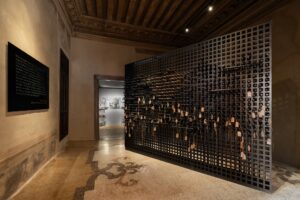At the 60th Venice International Art Exhibition – La Biennale di Venezia, post-colonial art and curatorship is emerging. The Venetian show, one of the most historic and important, has always been characterized by the desire to reconstruct contemporary needs. After curator Okwui Enwezor, in the 2015 edition, it is the director Adriano Pedrosa who is in charge of the Global South. The positive intention is to shift the center away from the West, hoping that a Western exposure will be enough to appease the distance it has created. But can an Art Biennale be de-colonized?

Nigeria Pavilion: Ndidi Dike, “Blackhood. A Living Archive”, 2024, courtesy Nigeria Pavilion
In the Arsenal and Giardini venues, the problems related to the scars of colonialism, the management of resources and the censored identity were listed. Although this visibility is important, the art of the South would seem to have simply crossed the threshold of the capitalist economic system. A problem is being replaced by a consequent one: the risk is that artworks, which were previously in the minority, could take their place among fashions. Who determines their value and taste? It is no coincidence that some artists and pavilions are among the central venues.

Nigeria Pavilion: Fatimah Tuggar, “Light Cream Pods (Excerpt)”, 2024, courtesy Nigeria Pavilion
At least though, some curators and artists seem to have taken the opportunity to present new non-Western research that resonates with museum issues. Among the most acclaimed pavilions there is the interesting view of Nigeria. From 2025 on display at the MOWAA (Museum of West African Art) in Benin City, Nigeria Imaginary frankly shows the three phases of the nation: the colonial past, the post-independence and the future. The habit of imagining a nation in crisis devoured by hunger is the misleading overview of imperialism. It is here that the curator Aindrea Emelife reports dynamic realities that are rarely known, as she does with Nigerian modernism. Eight intergenerational artists: Tunji Adeniyi-Jones, Ndidi Dike, Onyeka Igwe, Toyin Ojih Odutola, Abraham Oghobase, Yinka Shonibare CBE RA and Fatimah Tuggar. The goal of their research is to lay bare the needs by escaping the ghosts that still haunt the freedom of the country today.

Nigeria Pavilion: Yinka Shonibare CBE RA, “Monument To The Restitution Of The Mind And Soul”, 2023, courtesy Nigeria Pavilion
Among the greatest exponents, we find the iron criticism by Yinka Shonibare, who is mobilized between colonial looting and a present that seems immobile. Requests for the repatriation of cultural property are not answered. Although new methodologies have arrived to modify the ethnocentric museum system, thequestion to be asked is: what are we doing to improve colonial languages and past? Repatriation is an urgency, a responsibility that doesn’t seem to want to come: Shonibare contests it in Monument To The Restitution Of The Mind And Soul. The work recreates in clay a small sample of the artifacts stolen during the punitive expedition of the British navy that took place in 1897 at the expense of the Kingdom of Benin (now part of Nigeria). Among the pieces reproduced as a sign of vindication, the bust of the officer in charge emerges, now adorned with the batik textile style, one of the key elements of the artist’s policy, and enclosed in a display case. Its pyramidal construction is also fundamental, aimed at emphasizing the courageous freedom of artifacts to exist, ceasing to lay rigid in time and space as relics of a lost civilization to be possessed.

Installation view, “Nigeria Imaginary” at the Nigeria Pavilion at the 60th International Art Exhibition — La Biennale di Venezia
This structure is repeated, in different ways, throughout the exhibition. The curator idealizes a pavilion that acts as an Mbari Club, a workshop founded by young writers in the 1960s where art became a duty to the nation. It is a Nigeria aimed at problematizing the old methodologies. There are five alternative devices in the center of the main room: they are cubic or rectangular and they are mirrored. They reflect a replacement for the classic display cases. These displays offer food for thought on how to preserve the works, waiting to see them return to their homes. The intent for the moment is to project new structures to replace the old policies. Will we ever be ready to change them? Can sterilizations, walled-up cabinets in warehouses, glass cases adorned with security agents, distancing bars and alarms still represent the main system of display of goods plundered by colonialism?
Info:
AA.VV. Nigeria Imaginary
Nigeria Pavilion at the 60th International Art Exhibition – La Biennale di Venezia
20/04/2024 – 24/11/2024
Palazzo Canal, 3121 Rio Tera Canal Dorsoduro, Venice
https://www.nigeriaimaginary.com
Alessia D’introno has a degree in Visual Arts and is currently attending the two-year specialist course in Visual Arts and Curatorial Studies at Nuova Accademia di Belle Arti, NABA, Milan. She writes for the print and online magazine Juliet Art Magazine. Her critical work focuses on the demolition of historical paradigms to which Italy and Europe have been linked for centuries. The de-colonial practice of her research develops a comparison and an openness towards new methodologies and possibilities.






NO COMMENT